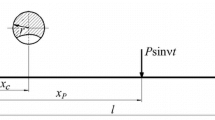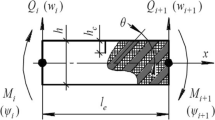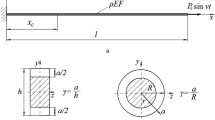The paper considers the results of determining the vibrodiagnostic indicators of the presence of various mode I breathing transverse cracks in rod elements of rectangular and circular cross section with different boundary conditions under longitudinal vibrations. Relative second harmonic amplitudes in the vibration spectrum at the main and superharmonic resonance of the first eigenmode of cantilever rods without mass and with a mass at the end and rods with the ends free for longitudinal displacements under forced and kinematic vibration excitation were taken as diagnostic indicators. To determine the above indicators, analytical and numerical bending vibration methods considered before are used. In the analytical solution, the nonlinearity parameter of the vibrating system is calculated using the corresponding values of stress intensity factors. The numerical solution is performed on the basis of eight-node finite element models with the representation of a breathing crack as a mathematical cut and the treatment of a contact problem in the formulation providing mutual nonpenetration between crack faces. Plots of the values of diagnostic indicators as a function of relative crack depth, crack location and the site of measurement of longitudinal displacements have been obtained. Comparisons of values of diagnostic indicators with the value of relative change in natural vibration frequency are presented. It has been shown that at the main resonance, the numerical solution confirms the pronounced effect of localization of diagnostic indicators in the crack region. It has been found that at the superharmonic resonance, the value of the vibrodiagnostic indicator is two orders of magnitude higher than that of the indicators at the main resonance, but the effect of their localization near the crack does not practically manifest itself. Some localization is observed for the absolute values of the second harmonic, and only for longitudinal strain, there is a strongly pronounced effect. A comparison of the obtained values of diagnostic indicators with the data for bending vibrations is given. It is noted that in spite of basically lower indicators under longitudinal vibrations, they have an advantage in terms of the possibility to diagnose symmetric both surface and internal breathing cracks.














Similar content being viewed by others
References
V. V. Matveev, A. P. Yakovlev, O. E. Boginich, and E. A. Sinenko, “Approximate analytical determination of vibrodiagnostic parameters of the presence of a closing crack in bar elements under subharmonic resonance,” Strength Mater., 46, No. 3, 315–327 (2014).
V. V. Matveev and E. A. Onishchenko, “Vibrodiagnostic parameters of the presence of a semielliptic breathing crack in circular bars under super- and subharmonic resonances,” Strength Mater., 48, No. 2, 195–207 (2016).
V. V. Matveev and E. A. Onishchenko, “Analysis of vibrodiagnostic parameters of the presence of a breathing surface crack of different configurations in a round bar,” Strength Mater., 49, No. 6, 739–750 (2017).
V. Hiwarkar, V. I. Babitsky, and V. V. Silberschmidt, “Damage assessment of a cracked bar: effect of material nonlinearity on vibro-impact response,” Key Eng. Mater., 413–414, 237–244 (2009).
F. B. Sayyad, B. Kumar, and S. A. Khan, “Approximate analytical method for damage detection in free-free beam by measurement of axial vibrations,” Int. J. Damage Mech., 22, No. 1, 133–142 (2013).
A. Vardhan and A. Singh, “Non-destructive testing based method for crack detection in beams,” Eng. Solid Mech., 2, No. 3, 193–200 (2014).
V. R. Niwarkar, V. I. Babitsky, and V. V. Silberschmidt, “Crack as modulator, detector and amplifier in structural health monitoring,” J. Sound Vib., 331, No. 15, 3587–3598 (2012).
D. Broda, L. Pieczonka, V. Hiwarkar, et al., “Generation of higher harmonics in longitudinal vibration of beams with breathing cracks,” J. Sound Vib., 381, 206–219 (2016).
V. V. Matveev and O. E. Boginich, “Approximate determination of vibrodiagnostic parameter of nonlinearity for an elastic body due to the presence of a breathing crack at a subharmonic resonance,” Strength Mater., 44, No. 3, 250–258 (2012).
Y. Murakami (Ed.), Stress Intensity Factors Handbook, in 2 volumes, Vol. 1, Pergamon Press, Oxford (1987).
C. S. Shin and C. Q. Cai, “Experimental and finite element analyses on stress intensity factors of an elliptical surface crack in a circular shaft under tension and bending,” Int. J. Fracture, 129, 239–264 (2004).
E. A. Sinenko and A. P. Zinkovskii, “Influence of the exciting force application point on the amplitude spectrum of flexural vibrations in a beam with a “breathing” crack,” Strength Mater., 47, No. 4, 553–560 (2017).
Author information
Authors and Affiliations
Additional information
Translated from Problemy Prochnosti, No. 4, pp. 33 – 51, July – August, 2018.
Rights and permissions
About this article
Cite this article
Matveev, V.V., Onishchenko, E.A. & Boginich, O.E. Vibration-Based Diagnostics of Transverse Surface Cracks in Rods of Different Cross Section Under Longitudinal Vibrations. Strength Mater 50, 540–556 (2018). https://doi.org/10.1007/s11223-018-9999-0
Received:
Published:
Issue Date:
DOI: https://doi.org/10.1007/s11223-018-9999-0




